
- Choosing Good Topics
- Controversial
- Demonstration
- Extemporaneous
- Informative
- School/College
- Special Occasion
- Public Speaking Help
- Writing a Speech
- Free Sample Speeches
- Share Your Speech
- Short Speech Topics

You will find 20 excellent short speech topics below that work when time is limited. Choosing a meaningful short speech topic may difficult in some circumstances.
As Mark Twain once said
If you want me to give a 2 hour presentation, I am ready today. If you want only a 5 minute speech, it will take me 2 weeks to prepare.
Because it's infinitely harder to communicate ideas and make an impact in a short space of time.
This, then, makes it that much more important to choose the right short speech topic.
Choose the wrong theme for your speech and you will struggle to deliver a presentation that covers it adequately. Choose the right topic, however, and you can create something powerful that will stick in the minds of your listeners, even if you are only able to speak for a few minutes.

Tips for Creating a Short Speech
- Pick something you feel strongly about. It's easier to make an impact in a short time when you speak with real passion.
- Pick something your audience is interested in too! All the passion in the world won't engage your listeners if the topic hold no interest for them!
- Consider speaking about a personal experience. Heartfelt emotions will be more keenly felt by your audience than those mustered up solely for the purpose of your speech!
- Focus on keeping your phrases brief and your words simple. See this page for help with this . A short speech is not the place for meandering thoughts and complicated sentence structures. Conciseness is key!
- Make sure your speech still includes the three key elements of any good presentation - a strong introduction , body and conclusion.
- Clearly identify the purpose of your speech. Is it to inform? Educate? Motivate? Criticize? Explain? Make sure that every word you write supports your overall purpose.
- Think hard before choosing a persuasive topic - this can be one of the most difficult types of speeches to deliver in a short space of time! It's not impossible, though - so be sure to have a strong argument if you want to convice people to think differently about something in only 5 minutes or so!
- Create a good title (if you will have the opportunity to use one).
Example Formats for Your Short Speech
Here's a simple template for a short persuasive speech...
SUPPORTING REASONS
1. _________ 2. _________ 3. _________
For example....
Treating All Children as 'Winners' - Regardless of Success - is Harmful
- SUPPORTING REASONS
1. It is not a reflection of real life. 2. It stifles competitiveness. 3. It does not reward hard work and achievement.
- CONCLUSION
For example....
- It is not a reflection of real life.
- It stifles competitiveness.
- It does not reward hard work and achievement.
- Whilst no one should be criticized for failure, success should be recognized and honored in order to encourage competitiveness in our children.
- INTRODUCTION
Have you always wondered how to make a paper plane that actually flies?
- CLEAR STEPS TO DEMONSTRATE
Fly the plane!
Demonstrations make great short speeches because these are very visual and thus make a big impact - but time yourself beforehand to be absolutely sure that you can complete your demonstration in the time allowed! Choose a good short speech topic like the ones listed below to ensure a successful presentation.
Problem and Solution
Divide this speech into 2 parts.
- First, set out the problem.
- Then, present the solution .
The problem part should be the longest . This may sound illogical, but it gives the solution more impact when the problem is presented in detail. Describe the problem as vividly as possible and the audience will be looking forward to hearing your ingenious solution!
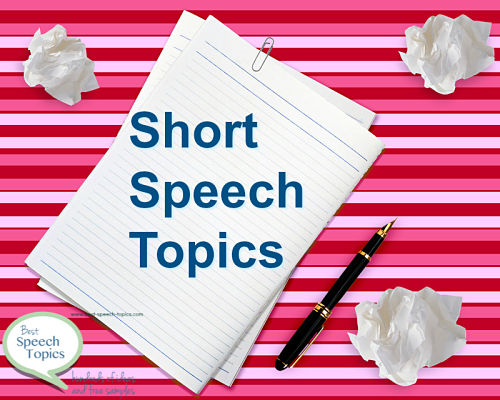
20 Short Speech Topics
- How social media is uniting the world
- Why pets are better than children
- 5 things to do with a Raspberry Pi
- How to solve the problem of online trolls
- My wish for humanity
- How to take the perfect selfie
- Why we should all be vegan
- If I were an animal I'd be a______
- A day in the life of a dollar bill
- The butterfly effect (how one tiny change in circumstances can alter the course of your life - focus on one example)
- 5 ways to save time in the kitchen
- If I had 5 minutes to talk to Donald Trump I would _____
- What advice I wish someone gave my parents before I was born
- Why the Gettysburg Address is the best speech ever written
- Online dating - cringeworthy or cool?
- My most embarrassing moment
- If I won the lottery I would _____
- Why ______ is the best book ever written
- Why it's sometimes necessary to lie
- How to write a short speech (they won't be expecting that one!)
Free email delivery
MASTER INFORMATIVE SPEAKING WITH OUR FREE CHECKLIST!
We are offering you a FREE SpeakFlight Informative Speaking Preparation Checklist. This valuable resource is packed with step-by-step guidance to help you create compelling, memorable, and effective informative speeches.
Share this page
You might like these.

Recent Topics for Speech Presentations that are Hot
Recent topics for speech on Best Speech Topics. These topics represent what is on the mind and will engage your audience with insights on contemporary issues.

Artificial Intelligence Speech Topics to Inform or Persuade
Here is a smart list of artificial intelligence speech topics to inform or persuade an audience. Learn about the issues AI presents and get ideas.

Interesting Speech Topics For Students on Personal Growth
Interesting Speech Topics For Students on Personal Growth and Development - ideal for high school and college students
- good speech topics for an informative speech
- good demonstration speech topics
- good persuasive speech topics
- good expository speech topics
- good controversial speech topics
- good impromptu speech topics
for more lists of topics to inspire you.
- Best Speech Topics
- Good Speech Topics

Easily search your speech type
Just check out the sitemap for best-speech-topics.com , which lists all the pages on the site, or use the search box below:
Return to the Top of the Page
Get to Know Us
- Privacy Policy
Attention Grabbers
- Positive Quotes for Kids
- Quotes for Graduation Speeches
- Poems & Quotes on Death
- Quotes on Retirement
Most Popular Pages
- Free Samples
- Hypnotize Your Audience
- Welcome Speech
Select a Speech Topic
- Argumentative
- Commemorative
- Inspirational
- Interesting
- Other Topics
Let Us Help You
- How To Write a Speech
- Demonstration Outline
- Informative Outline
- Introductions
- Using a Microphone
- Speech Help
- Speeches Made Easy
Writing and Delivering Spectacular Short Speeches (A-Z guide)
Hrideep barot.
- Public Speaking , Speech Topics , Speech Writing

Short speeches are bite-sized speeches . Unlike other speeches, short speeches try to provide consolidated and on-point information.
How long should short speeches be?
Short speeches are about 1 minute to 15 minutes long depending on the situation. Its duration is also dependent on the audience.
Human speech roughly comprises the ability to speak 100-150 words per minute . Depending upon the appropriate duration for a short speech in a situation, one can calculate how many words would be required.
It is advisable to keep at least a 15 seconds buffer while writing your short speech. As When you speak you may emphasize a point, make a joke, or give time to the audience to let a point sink in, all of which take up time, probably around 15 seconds to half a minute.
You are free to add more words depending on your speed of speaking and pace.
At the end of the day, the idea behind giving a speech is to convey a message to your audience
Things to keep in mind while writing ,
1-2 minute speeches.
One-minute speeches don’t leave you enough time to put forth many points, even in their most condensed form. Keeping one unexpected message in mind and making it the central point of your speech can prove to be effective in delivering your speech to your audience.
Quoting stories, anecdotes, facts, and figures to support your idea further can make your speech more impactful.
Lastly, having a simple opening line and restating your main idea in your conclusion should be sufficient to put your idea across.
A short speech for your Facebook audience works best when they are 1-3 minutes long.
5-minute speeches
A 600-800 words speech would be sufficient for a 5-minute speech.
5-minute speech gives you enough time to introduce your topic and elaborate on it. You can even add a minute to conclude your topic rather than just restating the main takeaway.
Ideally, the initial 1 minute is dedicated to the introduction. It can be an introduction to yourself or to your topic. Having more points can make your speech a little messy . Allocating a minute to each point and then concluding your speech can be an effective way of presenting your 5-minute speech.
Can a speech be too short?
Have you ever looked at a speaker and complained about their speech being too short? Rather opposite, we tend to like the speaker more for having the ability to fit all the relevant information in a short time.
But if you are looking for a specific word count or time duration, then it can be as short as George Washington ‘s second inaugural address which was 135 words long.
The idea behind giving any speech is to cover all the important points and not just to keep a check on the timer. It is the quality of your speech that reaches the audience. While the quantity of your speech , i.e., how long or short it is, comes secondary .
If you have been questioning how to create a short speech? and How to write good short speeches? the section below might guide you on how to do so.
Writing spectacular short speeches
A spectacular speech is one that has credibility, an emotional element, and logic.
Writing spectacular short speeches involves the following stages:
To make the process of writing short speeches easier for you to understand, Let’s take the example of making a cake . Might as well bake one later!
1. Ideation Stage

Before starting to make any cake, you’d first decide on which flavor of the cake you want to make, right?
In speech writing, this stage is concerned with deciding a topic for your speech .
If you have been given a broad topic, you might have to take a deeper look at what elements you wish to add. It is advisable to go for a topic that interests you the most and the one that the audience would like as well.
You can decide upon the information you want to add to your speech by answering the following questions:
What ? includes what the topic is, ie, its definition. What is the problem that you want to highlight? What is the situation in which the speech is to be given?
Who? is concerned with which section of people you will be talking about.
Why? Is concerned with reasoning as to why the topic is to be included and what the audience will gain from introducing this information to them. Hence, this forms your takeaway from the speech.
All these Who? What? Why? questions form the core of the ideation stage.
2. Collection stage

The next step in making a cake is getting all the ingredients we require.
In speech writing, this is the collection stage . Once you have a broad idea of what points you want to add to your speech, you can then go and research those specific topics.
Research plays a very important role when it comes to public speaking. A well-researched speech would be more credible for the audience, making it easier for them to trust your information and you. It also frees us of any biases or stereotypes we may be carrying as a speaker.
Ways to conduct your research
Depending on the purpose of your speech, you can choose any one research methodology or a combination of those given below.
a. Conducting Primary research
Primary Research is when you collect the data yourself . You can do it through surveys or interviews or any other means that is convenient for you.
Suppose you are giving a speech on success and want to add that grades do not affect your likelihood of succeeding in life. You can circulate a small survey asking people who are doing well in their fields about their grades and check for the results yourself.
b. Through secondary research
Secondary research is when you adopt the information or results from someone else’s research.
A plethora of freely available books, newspapers, and other sources online, make the task easier.
However, it is important to check for the credibility of these resources before committing to them in your speech.
A couple of websites that provide resources for free that you can use in your speech are:
- Research Papers: Google Scholar , Shodhganga
- Books: BookBub , Zlibrary
- Youtube: Bloomberg Quicktake , TED
The more diverse your research sources, the broader will be your perspective on your speech topic.
3. Structuring the information
Once you have collected all the information that you need, you might want to give it a proper structure.
The most basic format of writing a speech is:

The introduction includes basic information about the topic like its definition. You can also introduce a problem here.
In short speeches you don’t necessarily have to allot a lot of time introducing your topic, Hence keeping it short is always a good idea.
The body comprises a major part of your speech. It involves a detailed explanation of your topic. It may have a few subtopics that you may want to highlight. If you had introduced a problem in the introduction, then the body would include some solutions to that problem .
The conclusion is the summary of your speech .
While this is a structure we have learned since the day we were taught about speech writing, Another technique to structure and enhance your speech is the one given by Aristotle . It is a persuasive speech technique that includes the use of Ethos, Pathos, and Logos.
Ethos is the credibility element, Pathos means emotion , and Logos is the logical component .
I believe a lot of us here grew up privileged. When i say priveleged, we mean you had clothes to wear, a house to live in and food to eat, most probably you also had choices. Now try to imagine a life without those facilities (pathos) . About 689 million people today live under poverty (logos) . As a social activist and privleged citizen (Ethos) , I would like to address the issue of poverty today.
4. Enhancing Stage
The next step in making our cake is to get the right quantity of our ingredients in a bowl and mix them well.
This is the enhancing stage in speech writing, where you add a few things that would enhance your speech overall.
The use of literary techniques conveniently enhances any speech, no matter how mundane it may be. A few literary techniques that you can use are:
a. Tripling
A technique in which you take 3 words and group them together for maximum impact. The use of alliteration while tripling can make it even more impactful.
An example would be “His only philosophy of a fulfilling life was to love, laugh, and live .
The repetition of words in threes can also be used to exaggerate or evoke a particular emotion in the audience. This is called a Diacope . An example of Diacope that can be used in your speech on global warming could be: “With global warming on a rise, it is only going to get hotter and hotter and hotter with time.”
b. Cohesive ideas
Cohesive ideas refer to things that help in connecting two ideas . In simple terms, it includes the use of proper connectors like although, hence, and, because, furthermore, and so on.
Although it may seem irrelevant, It brings a sort of structure to your speech by connecting the ideas and forming a link.
An example of using cohesive ideas in your speech is given below:
According to the Evans Data Corporation, there are about 4.4 million software developers in North America. Although Washington, California, and Oregon are the top three recruiters for software developers in the USA; California has more software development positions which could be because of the famous silicon valley being located in North California. The average salary is expected to be around $126937 per year. However , Washington offers the highest salary at 164,000 per year.
c. Taking pauses
Taking necessary pauses is an effective way of getting across your information. It guides the audience on the ideas that you want them to focus on. Hence, It gives due emphasis to important sub-topics in your speech.
This is also an effective way to make your speech longer.
To learn ways in which you can harness the power of taking a pause in your speech, check out the video below.
5. Evaluation stage
Once we have mixed all the ingredients well, the next step in making our cake would be to pour the batter into a pan and keep it in the oven to cook, right?
In speech writing, this step can be called the Evaluation stage .
As you already have the first draft of your speech ready what you can do next is to see where your speech requires improvements. Keeping a timer can help you understand if there is time to add more information to your speech or if you need to compress it a little more.
This is when you decide on your pace of speaking.
After evaluation, If the speech is too short , you might want to add a few more points . Adding in a few stories can also prove to be helpful while engaging the audience at the same time. You can also open yourself up for a question-and-answer session after your speech. This would make your contribution longer with no change that would be required in your speech
For more ways to lengthen your speech, check out Ways to Make a Speech Longer .
And if the speech is too long you jump to the next step.

What do you do when you realize that the top layer of your cake is burnt? Most possibly you will trim that layer while making sure that it doesn’t ruin the shape of your cake.
Similarly, after a few evaluations of your speech, you can start editing it. The idea is to remove anything extra, repetitive, and even flowery words . In case any idea is going off the topic, it can be dropped.
You might also want to change passive voice to active voice.
Other aspects of your speech can be edited depending on the areas that need improvement.
An example of how you can edit your speech is given below
Climate change is here and the issue is only going to escalate quickly with time. 17% of Bangladesh is predicted to be submerged underwater by 2050. A lot of other cities like Mumbai in India, Tokyo in Japan, and New York City in the USA have been predicted to meet a similar fate.
An edited version of it could be:
Climate change is here and the issue is only going to escalate quickly with time. 17% of Bangladesh is predicted to be submerged underwater by 2050. A lot of other famous cities have also been predicted to meet a similar fate.
7. Final touch
Once we have given our cake a good shape, it is time for frosting and sprinkles!
Hence it is time for the Final touch in speech writing.
A few things you can use in your speech to enhance it more are:
a. Jokes : A little joke here or there would help lighten the mood of the audience. However, you must make sure that it is by no means derogatory to anyone.
It is okay if you are not confident in coming up with a joke yourself, You can even quote someone else’s joke.
An example of quoting someone to make your speech humorous is given below:
If in the first go you are not able to succeed in achieving your goals, do not give up right away. After all, it is your resilience and persistence that would eventually help you succeed and achieve your goals. But if at first, you don’t succeed, then skydiving definitely isn’t for you .” (Steven Wright)
A light-hearted and humorous story can also be added to your speech, provided it doesn’t make the speech unnecessarily long.
Ted talk by Vinay Menon is the best example of how you can casually add humor to your speech. He opens the speech by introducing himself when he says that he is both a lecturer and a stand-up comedian. He follows it by saying “ So most of you might be complaining about having a poorly-paying job; I’ve got two.”
Self-directed jokes would be a better option than targeting someone else or a community.
b. Quotes : Inserting quotes helps to enhance your credibility, especially if you are quoting some renowned personality.
If for example, your speech is about What is happiness? You might want to add a few quotes by personalities like Dalai Lama or even Buddha to your speech. One such quote could be:
Happiness is not something ready-made. It comes from your own actions. Dalai Lama
c. Props : Props make any concept easier to understand. It can also increase the likelihood of the audience believing in what you are saying.
While using props, you should make sure to use the prop early in your speech to not distract the audience and have them wondering what the prop is for.
In the video below, would you have believed if Lauren Singer simply said she lived a zero-waste lifestyle? probably not until you see all the waste she has collected in 3 years.
8. Practicing stage
The last thing to do with your cake before you munch on it is to let it set in the refrigerator for some time.
The practicing stage in speech writing is when we evaluate our final speech and practice it so that it sets perfectly for the day when we have to present.
You can practice using any technique that you are comfortable with. A few techniques you can use are:
- Recording : You can practice your speech by recording it on your phone. This will give you an opportunity to go back and check how you did. It would also help in a comparative analysis of your progress. You can compare your first video recorded to your most recent one, to see your improvements.
- Visualizing : Visualizing is a technique that involves visualizing or imagining as if you were giving a speech in front of a crowd. If convenient you can also go to the place where you will be presenting your speech and practice there while visualizing the place to be filled with a crowd.
- Look for a volunteer crowd : If possible you can also look for people who might be happy to help you practice. This volunteer crowd could even be your friends and family members.
Now you don’t need to follow the same steps in speech writing. You may skip a few or even go back and forth, as per your convenience. The thing you need to understand is that there are no set rules for speech writing .
The last step would be to enjoy your cake or in our case, the delivery of your speech.
Delivering spectacular short speeches
The delivery of short speeches can be different depending on the situation. Two broad differences are when you have presented the topic on the spot, that is an impromptu speech. And the second case is when you are given enough time to prepare for your speech.
Delivery of a Prepared Speech
A. make sure that the audience can hear you..
At times your voice may not reach the ones sitting far behind. It is better to make sure that everyone can hear you before you start your speech. As it will give you time to rectify that limitation at the beginning itself.
This can prove to be helpful especially if the situation doesn’t give you enough time to clarify the audience’s doubts later through a questions and answers session.
b. Simple speech opener
When it comes to short speeches, we often do not have a lot of time to form an initial rapport with the audience.
What you can do is start with an open-ended question. Such rhetorical questions require the speaker to ask a question and pause for some time to let the audience think. It also helps in setting enough curiosity among the audience members to make them listen to what you have to say.
You can also start by adding some humor through jokes as we discussed.
You can further start by bringing the audience’s attention to some fact or statistical information . An example would be “Did you know an estimated 5.6 million people die each year due to poor countries’ lack of access to proper healthcare?”
If you are looking for more opening lines for your short speech, consider watching the video below.
c. Storytelling
Again, while we know that there is no set time for short speeches, it still doesn’t have the flexibility of elongated time to explain the concept in detail.
Stories are one of the best ways to get the audience engaged. In short speeches, stories can be used to explain a concept. You can structure your speech in a way that conveys a story as well.
Delivery of an Impromptu Speech
While delivering impromptu speeches, you might not have enough time to spare and structure the information in a sequential manner. In these cases, you can follow a few models that might make the task of giving the speech easier for you.
a. PREP Model

The idea is to make a point, and give a reason that supports the point. The reason shall be followed by an example which would then introduce another point.
An example of using the PREP model when giving a best man speech could be
Hello everyone, I am XYZ, the best man of this amazing man who just got married (Point). All it took for me to get this title today was 10 years of ubering this fellow who is 32 and yet sits there proudly with no driving license (Reason). I still remember the first day of college when he made me wait for 2 hrs (Example). This day brings me immense joy as I gladly hand over my driver duties to (Bride’s name) (Point).
b. WWW model

The idea is to start by sharing who you are followed by some information on what you do. This shall be followed by answering the third question, that is, where are you going from here?
An example of the WWW model from a farewell speech could be:
Hello, I am XYZ (Who are you). I had been working as a product manager in this organization for the past 6 years (What do you do) and I’m grateful to all of you who have contributed to my journey here. I realized a few months ago that my contribution towards the work here and that my own venture was not meeting its mark. That was when I realized that it was the right time for me to bid goodbye so as to give my 100% to my own venture (Where you are going from here ) . Thank you again for such a wonderful working experience; I shall cherish them with me forever.
Short speeches by famous personalities
While there are a number of short speeches by famous personalities, 3 of the most hard-hitting short speeches we would like to take a look at are given below.
These are also some of the most inspiring short speeches of all time.
1. Leonardo DiCaprio
The speech given by Leonardo DiCaprio at the opening of the Climate Summit 2014 is an amazing example of a short 3-minute speech .
The way his speech has been structured is worth nothing. In the initial 1 minute, he introduces how humans have conveniently ignored the issue of climate change as if it were a work of fiction. He then proceeds to explain the grave effects of climate change that have already been observed. Thus establishing the need to take action Now.
He emphasizes the word “Now” to indicate the urgency of taking some action for climate change. This also forms his one takeaway.
He concludes by restating his takeaway in a very impactful manner by saying,
The time to address humnakind’s greatest challenge is Now .
2. Denzel Washington
One of the most motivating speeches of all time was given by Denzel Washington while receiving his image award for outstanding actor in Motion Picture.
The way he uses repetition to emphasize the phrase “Ease is a greater threat than progress,” and the use of tripling in “Keep moving, keep growing, keep learning” is commendable.
Another noteworthy feature of the speech is how he takes pauses and slows down when he wants to audience to focus on the word or the idea that he is talking about.
3. Malala Yousafzai
Malala Yousafzai who is well known for advocating education for girls, during her speech at the 2015 Nobel Concert showed some excellent skills that must be noted and if possible adopted in your speech.
She gracefully observes the room and starts with humor , when she says
Please have a seat, I know you have been standing a lot and clapping and people get tired.
She quotes statistics when she mentions that there are about 57 million children who are out of school , thus establishing her credibility and at the same time making people aware of the grave reality.
Lastly, she establishes one clear takeaway , when she urges the audience,
I want you to think about how can you help, how can you help these children to go to school
Short speech topics
Here is a list of unique short speech topics that you can make use of. The list also caters to short speech topics for students.
Final words
Writing and delivering short speeches don’t have any specific rules. You are free to choose a way that suits best for you and your speech.
The only idea is to make the content precise and to the point with little chance of drifting from the topic. Stories, jokes, and props can help in effectively delivering your speech to the audience.
No speech is too short, but it can be short of a meaningful takeaway.
Enroll in our transformative 1:1 Coaching Program
Schedule a call with our expert communication coach to know if this program would be the right fit for you

8 Steps to Success in the Field of Career Coaching

9 Tips for Writing a Maid of Honor Speech That Tugs at Heartstrings

How the 10,000-Hour Rule Applies to Public Speaking

- [email protected]
- +91 81691 99570
Get our latest tips and tricks in your inbox always
Copyright © 2023 Frantically Speaking All rights reserved
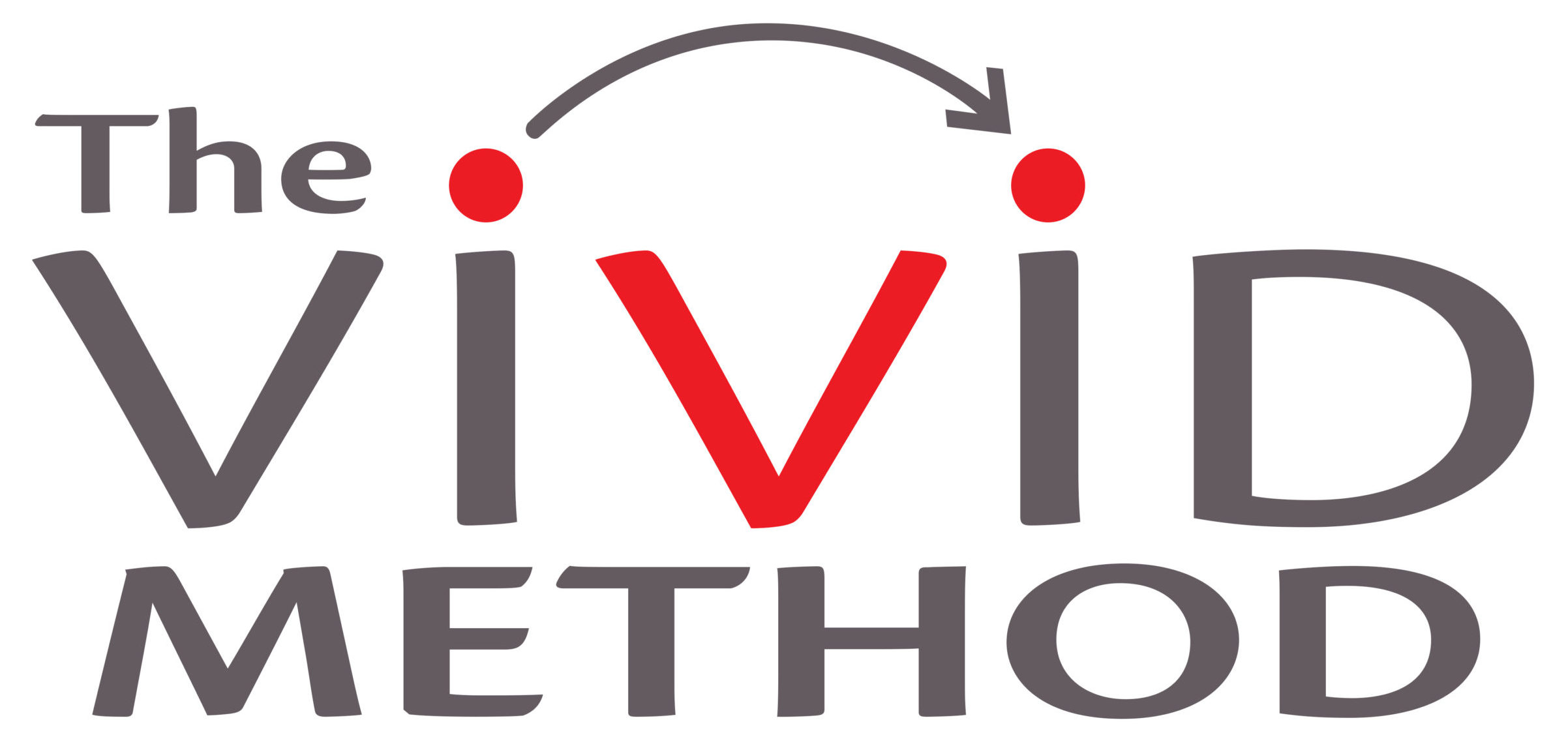
A short speech – create a 3 minute speech that rocks
I’m in the Charles Pearson Theatre at the University of Melbourne, watching 12 short speeches. It’s a 3 minute speech competition called the 3 minute Thesis .
These annual, 3 minute speech competitions challenge Ph.D and Masters students to effectively communicate 3-1/2 years’ of technical research into a short speech. Their task is to convey only the most important ideas and findings to a non-technical audience – and with only a single slide.

A short speech is a great test
As you’d imagine, it can be difficult to condense all that research and knowledge into a 3 minute speech, yet still convey all the pertinent information .
But that’s exactly why it’s such a great exercise for all speakers .
That’s because, in order to be effective, your ideas must be able to be communicated in the most brief, simple and clear manner possible. You need them to stick in the listener’s mind.
Not everyone is good at this skill – indeed, few people are. But you need to be if you want other to see the value of your ideas.
By the way, if you think giving a good 3 minute speech is hard, try doing one in just 5 words! That’s what they do at the Webby awards .
What did the winning speakers do right?
Despite giving a short speech on very different topics, there were some common practices I noticed about the winning speakers.
- They presented an exceptionally clear message .
- They included a “ top and tail ” element.
- They made use of metaphor and other verbal illustrations to simplify a complex idea.
- They spoke like they were having a conversation with their audience – not ‘giving a formal speech’.
The losing speakers, by contrast, were more forced. Some were so unnatural they seemed to be giving a pantomime a speech for an audience of children. The engagement of conversation was missing. We’ve talked before about the importance of an unforced, natural style .
How to create a short speech.
1. use a simple structure..
Start by clearly saying the ‘headline’ and key idea underpinning your speech in simple, everyday language, and follow with a simple structure supporting your main point. Here are some examples:
A: Headline and 3 supporting reasons:
With this approach, follow your “headline” statement with 3 simple supporting reasons. State each reason clearly, and explain how each one helps achieve or support the objective.
“We must change the way we work – for 3 important reasons:
- Thwack …,
- Kapow…,
- Whamm. “
B: Problem – solution:
This is a simple structure of only 2 parts. It’s an easy yet powerful way to capture people’s attention and interest when done well. But you’ll want to avoid the trap of rushing through the problem, and spending too much time on your brilliant solution.
If you really want to hook people, take some time to paint a vivid picture of the problem first. Your audience will then be clambering for a solution with both ears open.
C: Timeline:
In this type of short speech, you might cover:
- The history of the issue …
- The current situation …
- What might happen in the future …
- And the ramifications of agreeing (or disagreeing) with your main argument.
D: Metaphor/Top & Tail:
To “top and tail” simply means starting with a story/quote that hints at your message. At the end, you recall that story and link it to your message.
This short speech from a 3 minute speech competition makes excellent use of this approach.
Start your speech (“the top”) with a compelling metaphor to make a memorable point, and end the speech (“the tail”) with the same metaphor — but adjusted to show the benefit of adopting your central argument.
2: End with a memorable message:
Just as important as how you begin and structure your speech, is how you end it .
Consider the same techniques at the end of your speech. A metaphor that links back to your original premise, or finishing with a thought-provoking question, are two ways to burnish your speech in your listener’s mind.
These videos of the 1st and 2nd place winners of a 3 minute speech competition show how effective these closing techniques can be: 1st Place: Sara Ciesielski 2nd Place: Samantha Lichter
People worry that time limitations mean they have to ‘dumb down’ their valuable research — this is not the case!
A vivid message and a compelling short speech can become a window to the depth of your research, and give clarity to the value of your ideas.
A 3 minute speech gives you a huge amount of time to do this – if you use the time wisely and structure your speech to maximum effect.
Want to be a great speaker? Get the kindle ebook from amazon.com: What’s Your Message? Public Speaking with Twice the Impact, Using Half the Effort
- Home →
- Delivery Techniques →
How to Give a Speech: 10 Tips for Powerful Public Speaking
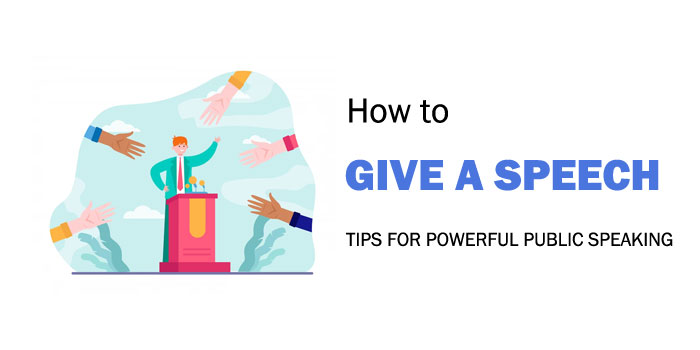
When we start preparing to give a speech, it can be a nerve-wracking experience. It’s completely normal—most of us feel a combination of excitement and nerves when we’re about to take the stage.
However, with some strategic planning and practical advice, you can make sure your speech is powerful and effective. In this blog post, we’ll explore how to give a speech that will leave your audience engaged and inspired.
We’ll examine 10 tips to help you build a powerful speech, from outlining your points methodically to crafting captivating introductions . Whether you’re a beginner or experienced public speaker, these nuggets of wisdom will help you take your next speech to the next level. Let’s get started!
Quick Review of Key Points
Preparing ahead of time is the key to giving an effective speech. Make sure to structure your speaking points, rehearse your delivery, and be aware of the needs of your audience for maximum impact.
How to Prepare for a Speech
Preparing for a speech is an essential step to public speaking success. It can help to build your confidence, create content that reaches the audience, and reduce performance anxiety.
Although it can be time-consuming in the beginning, preparation will ensure less stress and more comfort during delivery. Here are some tips to consider when preparing for a speech:
Practice : Before delivering a speech, practice it out loud several times. This will allow you to gain experience in speaking without an audience and increase your confidence when you do have one.
Practicing also helps to identify awkward moments in the speech or any difficult phrases which then can be changed or removed altogether. Additionally, it helps you determine where to pause for effect. Research : Depending on the topic of the speech , research should be done beforehand to gather information that is relevant and interesting for the audience. It is important to get acquainted with the language typically used by audiences to ensure a clear understanding of what is being said.
Additionally, relevant statistics and stories concerning the topic are a great way to draw in listeners and make the presentation more engaging .
Know Your Audience : When preparing your speech, be sure to consider who will be listening. For instance, if giving a presentation at work, include industry jargon that members would understand and include relevant topics from publications that might be familiar to the employees.
On the other hand, if consulting business professionals in their field then technical language may be easier for them to comprehend than laypeople or students.
By gathering valuable information about the topic and getting comfortable with a speech’s content and delivery through practice, speakers will gain more assurance during their talk as well as respect from their audience.
Preparing beforehand not only gives insight into how to engage listeners but also encourages more meaningful conversations after the event. Now that we have discussed how to prepare for a speech let us move on to creating an outline which will provide structure during delivery.
Create an Outline
After determining the audience and purpose of your speech, the next step to effective public speaking is to create an outline .
An outline serves as a roadmap to ensure that your speech has a logical flow and contains all important points. It also can help keep you on track during the speech itself, allowing you to stay focused and organized.
When constructing an outline, consider drawing up both a main point and sub-points for each portion of the speech. Both should be relevant to the goal of the presentation and backed up by facts and research.
Brainstorming can help in this process; try grouping your ideas together in clusters to make sure you cover all possible angles.
Furthermore, writing out exact quotations or figures can prove beneficial in forming a cohesive argument. At this stage, it is also wise to decide where transitions, humor, stories, or other engaging techniques will be included.
While there are differing opinions as to whether outlines should be memorized or simply used as a reference while speaking, many agree that they should serve their purpose – not only articulate the main thoughts of the speech but also assist the speaker with maintaining focus and preventing distractions.
The debate between those who advocate for memorization versus casual consulting touches upon issues such as rehearsal time, risk of errors in delivery, ease of practice versus actual performance and more.
Each side has valid arguments that should be weighed prior to deciding what type of approach best suits your needs.
Having a firmly constructed outline acts as a valuable tool when it comes time to deliver a powerful public speech. By actively utilizing this tactic, speakers may not only enhance their clarity and coherence, but also add structure and vibrance to their presentations.
Now that we have explored what goes into crafting an effective outline, let’s dive deeper into how we can best collect resources and research our topics for maximum impact.
Collect Sources and Research
Collecting sources and research is a crucial step for any public speaking engagement. It ensures that you have the necessary information to make strong points and back up your statements.
Before writing your speech, take time to research your topic to gain familiarity with different perspectives, facts, and counterpoints. This will help you to craft an argument that can stand up to scrutiny while also adding a breadth of knowledge to your speech.
Interviews can be a powerful source of evidence and anecdotes, so try to include one or two relevant interviews in your research process. Relying solely on secondary sources such as books and articles can lead to a narrow scope of understanding.
Interviews provide an opportunity to hear directly from an expert and create an interesting dynamic in your speech by adding personal experiences as well as commentary from a professional.
In research it is important to stay objective. Gather a variety of perspectives and be open-minded about their merits. Don’t forget to consider both sides of the argument when researching for your speech.
Doing this allows you to understand the opposing perspective and enables you to anticipate potential counter arguments from your audience.
By acknowledging them beforehand, you may increase the persuasive power of your speech by showing confidence in the points you make.
Once you have collected all sources, review them carefully and separate the most pertinent information from the less useful material.
Synthesising this information into concise yet impactful points is a critical part in delivering powerful talks without overloading your audience with too much data or going off track during your speech delivery.
Organizing Your Speech
Before you start putting your words together, it’s important to consider how the different parts of a speech fit together. By taking the time to organize the ideas in your speech , you’ll be able to deliver a presentation that is well-constructed and easy to understand.
One way to help with organizing your speech is to write an outline . An outline is like a map or plan that will provide you with a framework for each section of your speech.
Start by writing out your main points and then include additional details underneath each one. This will help keep your speech focused and provide direction for where you are going next.
Another approach for organizing your speech is known as the “inverted pyramid” method. This structure starts with your conclusion at the beginning of the speech, and then works backward by providing more explanation and detail as it moves toward the introduction.
This method can be helpful when speaking about topics that are unfamiliar to the audience since it doesn’t require them to wait until near the end of the presentation to learn what you’ve been talking about.
No matter which organization approach you choose, make sure to practice it before giving your speech so that you are comfortable with its flow. Lastly, remember that it’s ok to adjust things while you speak if they don’t seem or feel quite right.
Now let’s take a look at how we can use these organizing techniques to actually put our speeches together – starting with structuring our speech.
Structure Your Speech
Creating a strong structure for your speech will ensure that the audience stays engaged and understands your main points. As you are developing an outline, map out how you want to begin and end your speech.
Break up the information into smaller sections with either verbal or visual cues so that your audience can clearly see how you are transitioning between topics . Consider adding humor judiciously throughout your presentation as this could help engage the audience and lighten any tension.
The length of your presentation is also important. You will want to make sure that you include all of the necessary information without going over time.
Oftentimes less is more; if you can say it in five minutes why use ten? Make sure that you practice timed rehearsals so that you can gauge how long you’re actually speaking.
In contrast, avoid trying to pack too much content into one presentation as this could overwhelm both you and the audience. If needed, offer supplemental reading materials for those who may be interested in delving further into the subject matter.
Paragraphs can also be helpful when organizing large amounts of content within the body of your presentation. Utilizing paragraph breaks gives your audience a break and helps to highlight key ideas or summaries before moving onto a new topic area.
Finally, it is crucial to remember what your desired outcome is from the presentation; plan accordingly by ensuring that the beginning, middle, and end serve their respective purposes and adhere to that goal.
With careful deliberations, structuring a successful presentation can be achieved with relative ease.
Having established a solid structure for your speech, it’s important to focus on another key element: rehearsal. The next section will discuss the benefits of practicing before delivering a powerful public speaking performance.

Rehearse Your Speech
Rehearsing is integral to giving a successful speech. When you rehearse your presentation, you give your mind an opportunity to become familiar with the notes and concepts that you are presenting. It also increases your confidence and reduces anxiety or self-doubt.
In fact, studies have found that those who rehearsed their presentation had higher scores in public speaking performance and language proficiency evaluations.
When it comes to how much rehearsal is enough, opinions are divided. Some people believe that over-rehearsing can lead to a more robotic speech with less natural emotion and connection with the audience .
On the other hand, others argue that no matter how well-versed someone is on the topic, additional rehearsal time improves both the delivery of the speech and memorization of key points and facts.
Ultimately, it’s important to practice until you personally find the most comfortable level for yourself, as this will ultimately result in a more engaging delivery.
Finally, if at all possible, try to practice in front of a friend or colleague for honest feedback on any elements that need improvement before the big day. Rehearsal dedication may be tedious, but it results in big rewards on stage–enabling you to deliver your content with clarity, confidence, and poise.
With thoughtful preparation complete, it’s now time to step into the spotlight and give your speech!
Giving Your Speech
The key to success when giving a speech is to be well prepared and confident. Every individual’s preparation process will vary, but the basics should stay the same.
Start by studying your content, understanding the material and being able to repeat it in your own words. Clarify any potentially difficult points. Create visual aids like PowerPoint slides or handouts that supplement the key ideas in your speech.
Practice your public speaking skills with informal conversations with friends and family or rehearse it alone in front of a mirror. Use visualization; imagine yourself confidently delivering your speech. Consider addressing a practice audience if possible to become more accustomed to a live size group.
On the day of the event, arrive early and plan for any potential obstacles: What if my computer doesn’t work? What if I forget something? Allow sufficient time for setup and check-in.
When you are ready to give your speech, take some deep breaths, focus on the positives, and distract yourself from any anxious thoughts with positive affirmations. Remember you have prepared diligently for this moment, you are well prepared and you will succeed!
Start strong by engaging the audience immediately with an attention grabbing opening statement. Speak clearly and make sure that everyone can hear and understand your message.
Slow down and emphasize points as needed throughout your presentation. Be aware of pace, volume, and tone of voice: too fast/monotone can confuse/bore listeners while pauses add a dramatic effect that keeps their interest piqued.
Ultimately, giving a successful speech will depend on knowing your material well enough to speak confidently in front of your audience without hesitation or missteps.
When you do make a mistake (and they happen!) don’t panic – know that mistakes are inevitable but don’t be discouraged; get back on track as soon as possible and continue at the same energy level you had before the mistake occurred.
Having successfully given your speech, take a moment to reflect on what went well and what could be improved upon for next time before transitioning into the next step: mastering delivery.
Master Your Delivery
Mastering your delivery is the key to an effective speech. Without purposeful body language and careful emphasis on certain words , your speech may lack wow-factor and prevent listeners from tuning in. Following these simple tips can help you get started with delivering an engaging and memorable speech:
The most important part of delivery is practice. Rehearse and perfect your speech ahead of time – this allows for more natural flow and confidence during your presentation. It also helps to create pauses between sentences for clarity, emphasize key points, and not be too casual or stiff.
Practicing inflections and varying tones adds interest to your speech by keeping listeners’ attention.
Additionally, it’s important to project your voic e so everyone in the room can hear you; make sure you’re speaking loud enough but don’t feel pressure to shout or yell at any point unless that’s part of the atmosphere of the event.
It’s also crucial to maintain good posture while speaking – stand tall with both feet on the ground, keep your back straight, hold yourself up without gesturing too much or leaning against a podium if applicable.
To further engage listeners, use purposeful hand gestures as they help emphasize certain points and add visual interest – however, avoid overusing them as it can hinders communication.
Make meaningful eye contact with audience members throughout the presentation – otherwise you might come across as unenthusiastic or bored with what you’re saying which deters attention away from the content itself.
By mastering your delivery, you can boost the impact of your presentation considerably – providing a memorable experience for your audience that stands out from others’. As such, it’s worth investing time into practicing ahead of time until delivery feels comfortable and second nature.
Having said this, making use of visual aids such as PowerPoint slides can greatly improve the impact of a speech once delivery has been mastered – let’s look into that next.
Use Visual Aids
Using visual aids can help presenters express concepts more clearly and engage the audience.
Visuals are particularly useful when conveying complex information, such as data, trends, or statistics — they impart meaning at a glance. But some public speakers may wonder if visual aids can be distracting or unnecessary.
Even though visuals can attract attention away from a presenter’s verbal delivery, carefully designed visuals can actually support the speech and help provide clarity. If done well, visuals are effective for capturing an audience’s interest and helping them to better understand the content being presented.
For example, a graph or chart should relate to the points made in the speech and should be discussed in more detail during its appearance onscreen. The presentation can also include larger images that effectively reinforce the ideas conveyed in the speech.
Videos and sound clips are other powerful forms of multimedia that could be employed to make the speech more meaningful.
To ensure that visuals enhance the message of the presentation, key factors to consider include relevancy to topic, good graphic design or aesthetics, accurate size to prevent distortion or blurriness, and seamless integration into the keynote slides or printed handouts .
In this way, visuals offer an opportunity for presenters to demonstrate their creativity and keep their audiences interested in what is being said. Thus, used wisely and aptly, visuals can add tremendous value to speeches by presenting arguments more efficiently and driving home important points. Now let’s explore effective techniques for speech giving that will allow you to craft and deliver your speeches with confidence.
Effective Techniques for Speech Giving
There are a number of effective techniques for giving a speech that will help you deliver it with confidence and poise.
First, practice your delivery in advance. You should practice both in front of a mirror or recording device to check for any distracting habits such as talking too quickly or mispronouncing words.
Second, use simple, clear language and short, concise sentences. Avoid overly technical terms and jargon that may leave your audience confused.
Third, work to establish a connection with your audience by using appropriate facial expressions and hand gestures while speaking.
Fourth, utilize effective persuasive techniques such as presenting evidence, strong arguments supported by facts, personal anecdotes and vivid metaphors.
Finally, articulate an organized structure for your speech. Your speech should have an introduction, body and conclusion to clearly communicate the main point and provide the audience with the necessary context to understand it better.
While these techniques may sound intimidating at first, they can be learned over time with practice and will make all the difference in how successful your speech delivery is received by your audience.
To build on these skills further , the next section will provide tips on how to build confidence when giving a speech.
Building Confidence
Building confidence is key when giving a powerful speech, as it will enable you to deliver the speech in a more poised and credible manner.
To create this confidence , start by understanding that any hesitation or butterflies prior to your speech are completely normal and should not be feared. Instead, view them as natural states of anticipation for something exciting, knowing that you are about to give an amazing speech.
Next, understanding who your audience is and tailoring your speech to meet their expectations will help build your confidence.
Familiarizing yourself with their interests and knowledge on the subject matter ahead of time can equip you with the understanding needed to respond appropriately if questions arise or objections surface during the speech.
Further, practice is key when building confidence for a public speaking engagement . Rehearsing with friends or colleagues before hand will give you an opportunity to learn where problem areas are within the content of your speech, as well as help solidify your delivery by becoming more comfortable with each step.
Checking sound levels in the room you’re presenting in coupled with learning where exits/emergency locations are located within that space can also help alleviate stress levels and boost self-assurance while delivering the speech.
Finally, wearing comfortable clothing and dressing professionally adds an extra layer of confidence when speaking in public.
If possible, bring an additional outfit on hand during the presentation in case of spills or accidents that would require a quick change between sections of the talk. Having this back-up plan in place can aid in keeping peace of mind at ease throughout the speech.
In conclusion, building confidence prior to a public speaking event can mean the difference between a good and great delivery of your message.
By taking into account each of these tips you can ensure that this part of your preparation runs smoothly and sets you up for success when delivering powerful speeches.
With a well-crafted note card of talking points and strong sense of self-assurance, it’s time to start speaking with passion!
Speaking with Passion
As a public speaker, your audience expects you to engage not only with your words but also with your emotions. To share the most impactful message, it is important to speak passionately about your subject.
Doing so will make your speech more memorable and thereby more effective in convincing your audience of its legitimacy.
The power of speaking authentically with emotion lies in its relatability and connection. Showing feelings allows people to connect with you as a person rather than just a speaker. It opens the door to understanding through empathy and active listening .
Examples might include adding personal stories , telling jokes, or displaying your feelings openly during the delivery of your message.
However, not all topics lend themselves easily to expressing emotion. If the subject matter is overly complex or technical there may be less opportunity for emotional expression—but this doesn’t mean those conversations can’t incorporate emotion.
Even if faced with a difficult situation such as death or financial turmoil, emotions can still be conveyed in a respectful way that keeps audiences engaged.
Remember that how much emotion you show depends on the type of audience you’re sharing it with—using sensitivity when delivering passionate speeches helps avoid awkwardness or embarrassment for any attendees who may find opinionated language uncomfortable for whatever reason.
Striking the right balance between being straightforward and showing compassion takes practice, so take the time to develop a style that works best for you and improves upon each performance.
Finally, incorporating passion into a speech gives it life and makes it relatable and engaging—which are essential elements to speaking effectively.
Having passion means giving ourselves permission to take ownership over our stories, making them deeply personal in order to reach our goals and touch people’s hearts in meaningful ways. With that said, let’s move on to discussing how we should tackle dealing with challenges while giving a speech.
Dealing with Challenges
The process of delivering a speech can be challenging, but it is also rewarding. Difficulties can arise during the process that may threaten to derail your success. To ensure you are adequately prepared for these possible pitfalls it is important to consider strategies for proactively mitigating the risk of encountering these challenges. 1. Public Speaking Anxiety: Many people experience some form of anxiety when asked to speak in public. There are a number of techniques available to combat this fear and increase confidence, such as deep breathing exercises, mental rehearsal, positive self-talk and visualization of success.
Learning about the audience, creating an engaging presentation and using props or visual aids can also help reduce anxiety levels and create a better overall experience for both the speaker and the audience. 2. Unfamiliar Topics or Audiences: When presenting on unfamiliar topics or to an unknown audience it can be difficult to prepare effectively.
In this situation it is important to conduct research on the topic and familiarize yourself with the needs of your audience so that the content is tailored accordingly. It is also helpful to use humor or stories related to the topic in order to engage your audience and make them more receptive to your message. 3. Lack of Support: If you lack support from family, friends, colleagues or mentors, it can be difficult to push through difficult conversations or speeches without any additional motivation.
To overcome this challenge, seek out peer mentorship opportunities or find compatible online communities where people discuss similar topics or objectives. Here you can share ideas, provide feedback and learn from others who have experienced similar issues. 4. Time Constraints: One of the biggest challenges when giving a speech is managing your time effectively in order to deliver an effective message without going over allotted timeslots and boring your audience .
To successfully address this challenge try setting manageable goals for each section of your speech and practice regularly. Replicating real-time conditions as closely as possible will help you stay within time constraints when delivering your speech on the day itself. In conclusion, there are many potential challenges you may face when giving a speech or taking part in a public speaking event – but with proper preparation and practice they are easily managed if approached correctly.
With knowledge of techniques for dealing with such scenarios comes increased confidence when stepping up to the podium – further improving your chances of delivering an effective speech that resonates with your audience members.
Responses to Frequently Asked Questions
How should i end my speech to leave a lasting impression.
The best way to end your speech is by reinforcing your main point and summarizing the key takeaways. You should also encourage the audience to take action, whether it be to sign up for a newsletter, make a donation, or visit your website for more information. This final call to action will not only leave a lasting impression on the audience but will also help you achieve any goals you might have had when making your speech in the first place.
What techniques can I use to keep my audience engaged during my speech?
One of the best techniques for keeping an audience engaged during a speech is to keep it interactive . Ask questions throughout the presentation, as well as allowing for audience input and discussion. This can help to keep people’s attention and create a more engaging experience.
Another great tip is to use humor. Even if you don’t consider yourself a natural comedian, sprinkling in a few jokes here and there can break up the monotony of long speeches and keep people interested. Humor can also help to make points stick in people’s minds, making them easier to remember.
Finally, try to be enthusiastic about the content of your speech. If you show too much indifference or lethargic behavior, it will discourage your audience from paying attention and taking your message seriously.
Instead, be passionate about what you are saying so that the energy of your words carries into the room and engages your audience with excitement.
How can I use storytelling to make my speech more interesting?
Storytelling is a powerful tool that can be used to make any speech more interesting. Telling stories in your speech will help engage the audience and make your message stick. Here are some tips for using storytelling in your speech:
1. Choose stories that are relevant to your message and audience. Think about stories that will best illustrate the point you are trying to convey, or evoke emotions in your listeners. 2. Use vivid descriptions and visuals when telling your story. Be sure to include details such as setting, character descriptions, dialogue and plot points. This will help to bring the story to life for your audience. 3. Make sure the story you are telling has a strong conclusion or moral at the end. This will help add emphasis to your message and make it memorable. 4. Practice telling stories out loud before delivering a speech with them. Rehearsing will help you deliver your story more effectively and with more confidence in front of an audience. By using these tips, storytelling can be an effective tool to make any speech more interesting, engaging, and persuasive!
How can I prepare for my speech effectively?
Preparing for a speech effectively is essential to delivering an impactful and memorable presentation. Here are some tips: 1. Have a clear goal in mind. Before starting to prepare, ask yourself what the purpose of giving the speech is: what message do you want to convey? Defining this will help to structure your content and focus your research. 2. Research thoroughly. Make sure you understand the subject matter well, so that your delivery sounds confident and inspiring. Using facts and data will strengthen your arguments and make your talk more convincing. 3. Outline your speech. Make a rough outline of how you want it to go – from beginning to end – well in advance of the actual presentation. This will give you a strong foundation upon which you can craft an engaging talk with an effective narrative arc that keeps audiences interested and engaged. 4. Practice regularly. Rehearsing your speech out loud several times is key to ensuring that you know it well enough to feel comfortable when delivering it live in front of an audience.
5. Time yourself. Record how long it takes for you to go through your entire speech, so that you can adjust the length as needed before delivering it live – remember that most speeches should last no more than 10-15 minutes. 6. Identify potential questions from the audience and prepare answers before hand. Knowing ahead of time what kind of questions people may ask can help reduce the anxiety of not knowing what comes next, enabling you to stay confident when speaking in public. 7. Work on building up confidence levels before delivering a speech. Visualize yourself succeeding in delivering a great presentation; practice relaxation techniques such as deep breathing or positive self-talk; or use props during practice sessions such as water bottles or stress balls if needed to remain calm during the real thing!
What strategies can I use to reduce my anxiety when giving a speech?
1. Plan Ahead: Create an outline of your speech beforehand and practice it multiple times to become familiar with the content. Doing a trial run with the audience can also help you get used to speaking in front of people.
2. Visualize Success: Positive visualization is a great way to reduce anxiety before giving a speech. Imagine yourself confidently delivering the speech while feeling relaxed and composed.
3. Get Organized: Make sure you have all the materials necessary for your presentation, including notes, slides, etc., to reduce any additional stress that may come from not having what you need when you speak.
4. Take Deep Breaths: Before and during the speech, take a few deep breaths as this will help calm nerves and make sure your breathing is regulated throughout the duration of your presentation.
5. Speak Slowly: It is common to feel anxious while giving a speech and try to rush through it too quickly. Speaking slowly helps maintain composure while delivering your message effectively and clearly.
6. Pay Attention to Your Body: Your posture, stance, movements , facial expressions can all influence how confident you appear to your audience and how nervous you may be feeling inside. Check in with yourself frequently throughout the presentation and correct any tense body language or physical actions if needed.
7. Focus on the Audience: If you notice that your anxiety levels are growing as you present, shift your focus onto the audience instead of yourself as this will help refocus your attention away from negative thoughts that may arise from fear or insecurity.
8. Make Eye Contact: Establishing eye contact with your audience is a key confidence-builder for public speakers—it shows that you’re strong, engaged with them, and receptive to feedback or questions they might have regarding your speech topic .
9. Practice Positive Affirmations: Positive thoughts will boost your self-confidence as well as your mood which can help increase performance quality significantly during speeches or presentations in general—so don’t forget to tell yourself “you can do it!” several times throughout the day leading up to the event!
10. Seek Support of Friends & Family: Many experienced public speakers suggest seeking support of close friends & family members prior and during their speeches—not only does it allow helpful critique regarding content but it also creates a more comfortable atmosphere while speaking which can reduce pre-speech jitters drastically.
- Games, topic printables & more
- The 4 main speech types
- Example speeches
- Commemorative
- Declamation
- Demonstration
- Informative
- Introduction
- Student Council
- Speech topics
- Poems to read aloud
- How to write a speech
- Using props/visual aids
- Acute anxiety help
- Breathing exercises
- Letting go - free e-course
- Using self-hypnosis
- Delivery overview
- 4 modes of delivery
- How to make cue cards
- How to read a speech
- 9 vocal aspects
- Vocal variety
- Diction/articulation
- Pronunciation
- Speaking rate
- How to use pauses
- Eye contact
- Body language
- Voice image
- Voice health
- Public speaking activities and games
- Blogging Aloud
- About me/contact
How to write a good speech in 7 steps
By: Susan Dugdale
- an easily followed format for writing a great speech
Did you know writing a speech doesn't have be an anxious, nail biting experience?
Unsure? Don't be.
You may have lived with the idea you were never good with words for a long time. Or perhaps giving speeches at school brought you out in cold sweats.
However learning how to write a speech is relatively straight forward when you learn to write out loud.
And that's the journey I am offering to take you on: step by step.
To learn quickly, go slow
Take all the time you need. This speech writing format has 7 steps, each building on the next.
Walk, rather than run, your way through all of them. Don't be tempted to rush. Familiarize yourself with the ideas. Try them out.
I know there are well-advertised short cuts and promises of 'write a speech in 5 minutes'. However in reality they only truly work for somebody who already has the basic foundations of speech writing in place.
The foundation of good speech writing
These steps are the backbone of sound speech preparation. Learn and follow them well at the outset and yes, given more experience and practice you could probably flick something together quickly. Like any skill, the more it's used, the easier it gets.
In the meantime...
Step 1: Begin with a speech overview or outline
Are you in a hurry? Without time to read a whole page? Grab ... The Quick How to Write a Speech Checklist And come back to get the details later.
- WHO you are writing your speech for (your target audience)
- WHY you are preparing this speech. What's the main purpose of your speech? Is it to inform or tell your audience about something? To teach them a new skill or demonstrate something? To persuade or to entertain? (See 4 types of speeches: informative, demonstrative, persuasive and special occasion or entertaining for more.) What do you want them to think, feel or do as a result of listening the speech?
- WHAT your speech is going to be about (its topic) - You'll want to have thought through your main points and have ranked them in order of importance. And have sorted the supporting research you need to make those points effectively.
- HOW much time you have for your speech eg. 3 minutes, 5 minutes... The amount of time you've been allocated dictates how much content you need. If you're unsure check this page: how many words per minute in a speech: a quick reference guide . You'll find estimates of the number of words required for 1 - 10 minute speeches by slow, medium and fast talkers.
Use an outline
The best way to make sure you deliver an effective speech is to start by carefully completing a speech outline covering the essentials: WHO, WHY, WHAT and HOW.
Beginning to write without thinking your speech through is a bit like heading off on a journey not knowing why you're traveling or where you're going to end up. You can find yourself lost in a deep, dark, murky muddle of ideas very quickly!
Pulling together a speech overview or outline is a much safer option. It's the map you'll follow to get where you want to go.
Get a blank speech outline template to complete
Click the link to find out a whole lot more about preparing a speech outline . ☺ You'll also find a free printable blank speech outline template. I recommend using it!
Understanding speech construction
Before you begin to write, using your completed outline as a guide, let's briefly look at what you're aiming to prepare.
- an opening or introduction
- the body where the bulk of the information is given
- and an ending (or summary).
Imagine your speech as a sandwich
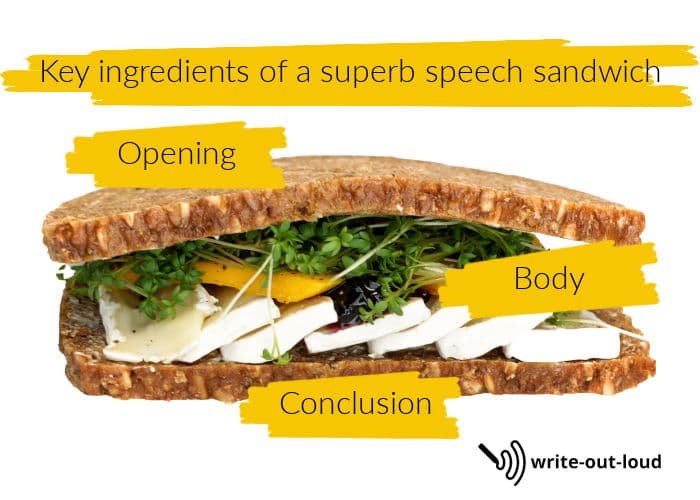
If you think of a speech as a sandwich you'll get the idea.
The opening and ending are the slices of bread holding the filling (the major points or the body of your speech) together.
You can build yourself a simple sandwich with one filling (one big idea) or you could go gourmet and add up to three or, even five. The choice is yours.
But whatever you choose to serve, as a good cook, you need to consider who is going to eat it! And that's your audience.
So let's find out who they are before we do anything else.
Step 2: Know who you are talking to
Understanding your audience.
Did you know a good speech is never written from the speaker's point of view? ( If you need to know more about why check out this page on building rapport .)
Begin with the most important idea/point on your outline.
Consider HOW you can explain (show, tell) that to your audience in the most effective way for them to easily understand it.
Writing from the audience's point of view

To help you write from an audience point of view, it's a good idea to identify either a real person or the type of person who is most likely to be listening to you.
Make sure you select someone who represents the "majority" of the people who will be in your audience. That is they are neither struggling to comprehend you at the bottom of your scale or light-years ahead at the top.
Now imagine they are sitting next to you eagerly waiting to hear what you're going to say. Give them a name, for example, Joe, to help make them real.
Ask yourself
- How do I need to tailor my information to meet Joe's needs? For example, do you tell personal stories to illustrate your main points? Absolutely! Yes. This is a very powerful technique. (Click storytelling in speeches to find out more.)
- What type or level of language is right for Joe as well as my topic? For example, if I use jargon (activity, industry or profession specific vocabulary) will it be understood?
Step 3: Writing as you speak
Writing oral language.
Write down what you want to say about your first main point as if you were talking directly to Joe.
If it helps, say it all out loud before you write it down and/or record it.
Use the information below as a guide
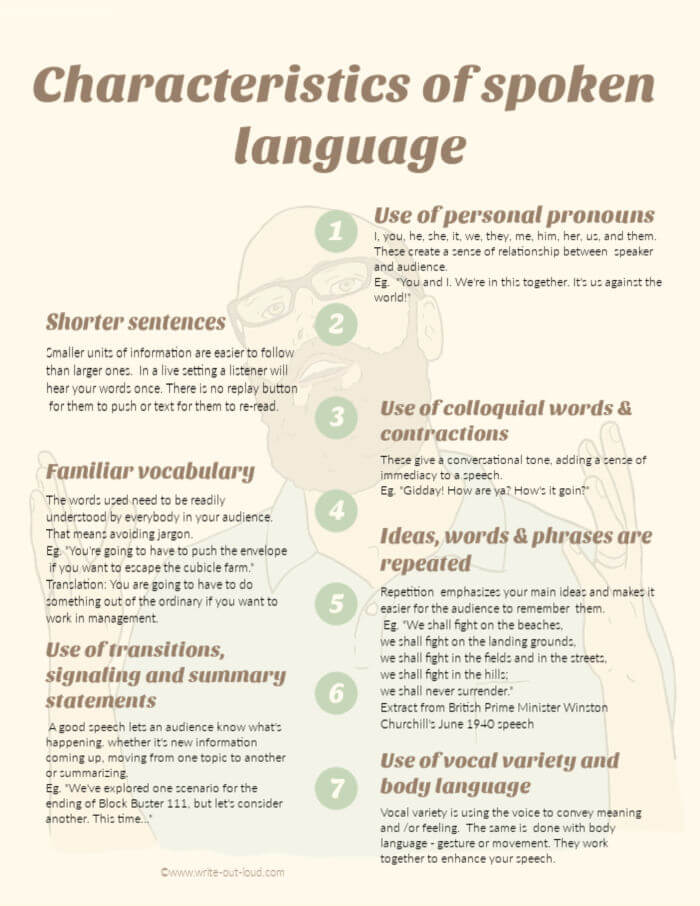
(Click to download The Characteristics of Spoken Language as a pdf.)
You do not have to write absolutely everything you're going to say down * but you do need to write down, or outline, the sequence of ideas to ensure they are logical and easily followed.
Remember too, to explain or illustrate your point with examples from your research.
( * Tip: If this is your first speech the safety net of having everything written down could be just what you need. It's easier to recover from a patch of jitters when you have a word by word manuscript than if you have either none, or a bare outline. Your call!)
Step 4: Checking tone and language
The focus of this step is re-working what you've done in Step 2 and 3.
You identified who you were talking to (Step 2) and in Step 3, wrote up your first main point. Is it right? Have you made yourself clear? Check it.
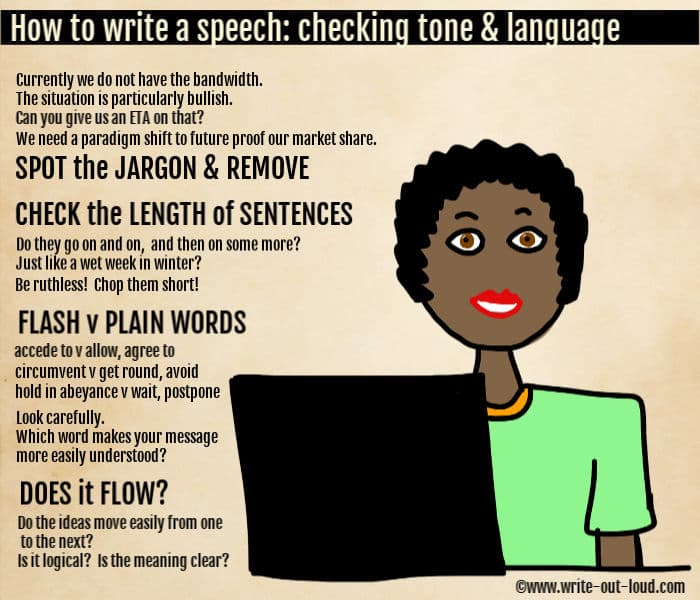
How well you complete this step depends on how well you understand the needs of the people who are going to listen to your speech.
Please do not assume because you know what you're talking about the person (Joe) you've chosen to represent your audience will too. Joe is not a mind-reader!
How to check what you've prepared
- Check the "tone" of your language . Is it right for the occasion, subject matter and your audience?
- Check the length of your sentences. You need short sentences. If they're too long or complicated you risk losing your listeners.
Check for jargon too. These are industry, activity or group exclusive words.
For instance take the phrase: authentic learning . This comes from teaching and refers to connecting lessons to the daily life of students. Authentic learning is learning that is relevant and meaningful for students. If you're not a teacher you may not understand the phrase.
The use of any vocabulary requiring insider knowledge needs to be thought through from the audience perspective. Jargon can close people out.
- Read what you've written out loud. If it flows naturally, in a logical manner, continue the process with your next main idea. If it doesn't, rework.
We use whole sentences and part ones, and we mix them up with asides or appeals e.g. "Did you get that? Of course you did. Right...Let's move it along. I was saying ..."
Click for more about the differences between spoken and written language .
And now repeat the process
Repeat this process for the remainder of your main ideas.
Because you've done the first one carefully, the rest should follow fairly easily.
Step 5: Use transitions
Providing links or transitions between main ideas.
Between each of your main ideas you need to provide a bridge or pathway for your audience. The clearer the pathway or bridge, the easier it is for them to make the transition from one idea to the next.
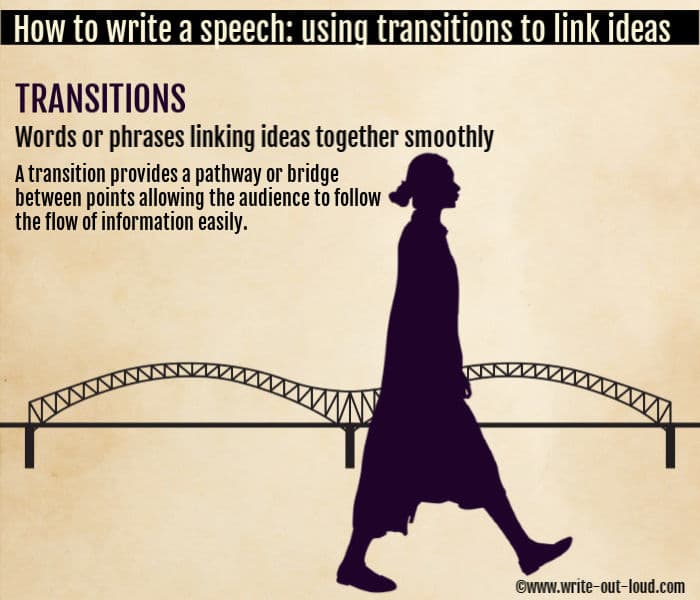
If your speech contains more than three main ideas and each is building on the last, then consider using a "catch-up" or summary as part of your transitions.
Is your speech being evaluated? Find out exactly what aspects you're being assessed on using this standard speech evaluation form
Link/transition examples
A link can be as simple as:
"We've explored one scenario for the ending of Block Buster 111, but let's consider another. This time..."
What follows this transition is the introduction of Main Idea Two.
Here's a summarizing link/transition example:
"We've ended Blockbuster 111 four ways so far. In the first, everybody died. In the second, everybody died BUT their ghosts remained to haunt the area. In the third, one villain died. His partner reformed and after a fight-out with the hero, they both strode off into the sunset, friends forever. In the fourth, the hero dies in a major battle but is reborn sometime in the future.
And now what about one more? What if nobody died? The fifth possibility..."
Go back through your main ideas checking the links. Remember Joe as you go. Try each transition or link out loud and really listen to yourself. Is it obvious? Easily followed?
Keep them if they are clear and concise.
For more about transitions (with examples) see Andrew Dlugan's excellent article, Speech Transitions: Magical words and Phrases .
Step 6: The end of your speech
The ideal ending is highly memorable . You want it to live on in the minds of your listeners long after your speech is finished. Often it combines a call to action with a summary of major points.

Example speech endings
Example 1: The desired outcome of a speech persuading people to vote for you in an upcoming election is that they get out there on voting day and do so. You can help that outcome along by calling them to register their support by signing a prepared pledge statement as they leave.
"We're agreed we want change. You can help us give it to you by signing this pledge statement as you leave. Be part of the change you want to see!
Example 2: The desired outcome is increased sales figures. The call to action is made urgent with the introduction of time specific incentives.
"You have three weeks from the time you leave this hall to make that dream family holiday in New Zealand yours. Can you do it? Will you do it? The kids will love it. Your wife will love it. Do it now!"
How to figure out the right call to action
A clue for working out what the most appropriate call to action might be, is to go back to your original purpose for giving the speech.
- Was it to motivate or inspire?
- Was it to persuade to a particular point of view?
- Was it to share specialist information?
- Was it to celebrate a person, a place, time or event?
Ask yourself what you want people to do as a result of having listened to your speech.
For more about ending speeches
Visit this page for more about how to end a speech effectively . You'll find two additional types of speech endings with examples.
Write and test
Write your ending and test it out loud. Try it out on a friend, or two. Is it good? Does it work?
Step 7: The introduction
Once you've got the filling (main ideas) the linking and the ending in place, it's time to focus on the introduction.
The introduction comes last as it's the most important part of your speech. This is the bit that either has people sitting up alert or slumped and waiting for you to end. It's the tone setter!
What makes a great speech opening?
Ideally you want an opening that makes listening to you the only thing the 'Joes' in the audience want to do.
You want them to forget they're hungry or that their chair is hard or that their bills need paying.
The way to do that is to capture their interest straight away. You do this with a "hook".
Hooks to catch your audience's attention
Hooks come in as many forms as there are speeches and audiences. Your task is work out what specific hook is needed to catch your audience.
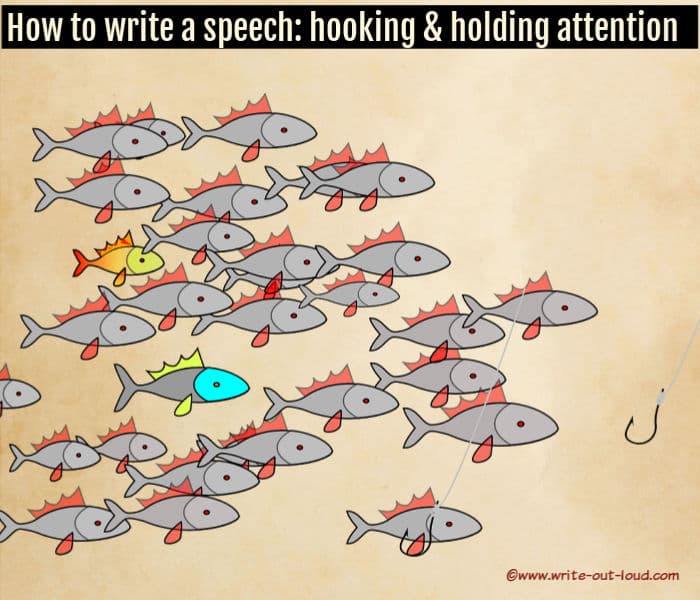
Go back to the purpose. Why are you giving this speech?
Once you have your answer, consider your call to action. What do you want the audience to do, and, or take away, as a result of listening to you?
Next think about the imaginary or real person you wrote for when you were focusing on your main ideas.
Choosing the best hook
- Is it humor?
- Would shock tactics work?
- Is it a rhetorical question?
- Is it formality or informality?
- Is it an outline or overview of what you're going to cover, including the call to action?
- Or is it a mix of all these elements?
A hook example
Here's an example from a fictional political speech. The speaker is lobbying for votes. His audience are predominately workers whose future's are not secure.
"How's your imagination this morning? Good? (Pause for response from audience) Great, I'm glad. Because we're going to put it to work starting right now.
I want you to see your future. What does it look like? Are you happy? Is everything as you want it to be? No? Let's change that. We could do it. And we could do it today.
At the end of this speech you're going to be given the opportunity to change your world, for a better one ...
No, I'm not a magician. Or a simpleton with big ideas and precious little commonsense. I'm an ordinary man, just like you. And I have a plan to share!"
And then our speaker is off into his main points supported by examples. The end, which he has already foreshadowed in his opening, is the call to vote for him.
Prepare several hooks
Experiment with several openings until you've found the one that serves your audience, your subject matter and your purpose best.
For many more examples of speech openings go to: how to write a speech introduction . You'll find 12 of the very best ways to start a speech.
That completes the initial seven steps towards writing your speech. If you've followed them all the way through, congratulations, you now have the text of your speech!
Although you might have the words, you're still a couple of steps away from being ready to deliver them. Both of them are essential if you want the very best outcome possible. They are below. Please take them.
Step 8: Checking content and timing
This step pulls everything together.
Check once, check twice, check three times & then once more!
Go through your speech really carefully.
On the first read through check you've got your main points in their correct order with supporting material, plus an effective introduction and ending.
On the second read through check the linking passages or transitions making sure they are clear and easily followed.
On the third reading check your sentence structure, language use and tone.
Double, triple check the timing
Now go though once more.
This time read it aloud slowly and time yourself.
If it's too long for the time allowance you've been given make the necessary cuts.
Start by looking at your examples rather than the main ideas themselves. If you've used several examples to illustrate one principal idea, cut the least important out.
Also look to see if you've repeated yourself unnecessarily or, gone off track. If it's not relevant, cut it.
Repeat the process, condensing until your speech fits the required length, preferably coming in just under your time limit.
You can also find out how approximately long it will take you to say the words you have by using this very handy words to minutes converter . It's an excellent tool, one I frequently use. While it can't give you a precise time, it does provide a reasonable estimate.

Step 9: Rehearsing your speech
And NOW you are finished with writing the speech, and are ready for REHEARSAL .
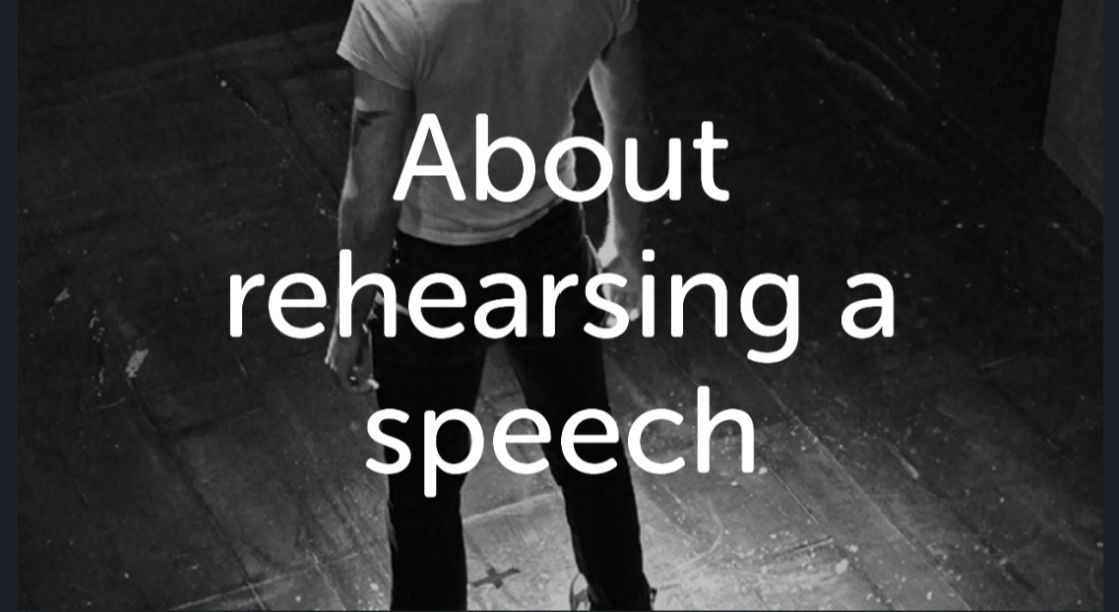
Please don't be tempted to skip this step. It is not an extra thrown in for good measure. It's essential.
The "not-so-secret" secret of successful speeches combines good writing with practice, practice and then, practicing some more.
Go to how to practice public speaking and you'll find rehearsal techniques and suggestions to boost your speech delivery from ordinary to extraordinary.
The Quick How to Write a Speech Checklist
Before you begin writing you need:.
- Your speech OUTLINE with your main ideas ranked in the order you're going to present them. (If you haven't done one complete this 4 step sample speech outline . It will make the writing process much easier.)
- Your RESEARCH
- You also need to know WHO you're speaking to, the PURPOSE of the speech and HOW long you're speaking for
The basic format
- the body where you present your main ideas
Split your time allowance so that you spend approximately 70% on the body and 15% each on the introduction and ending.
How to write the speech
- Write your main ideas out incorporating your examples and research
- Link them together making sure each flows in a smooth, logical progression
- Write your ending, summarizing your main ideas briefly and end with a call for action
- Write your introduction considering the 'hook' you're going to use to get your audience listening
- An often quoted saying to explain the process is: Tell them what you're going to tell them (Introduction) Tell them (Body of your speech - the main ideas plus examples) Tell them what you told them (The ending)
TEST before presenting. Read aloud several times to check the flow of material, the suitability of language and the timing.

- Return to top
speaking out loud
Subscribe for FREE weekly alerts about what's new For more see speaking out loud

Top 10 popular pages
- Welcome speech
- Demonstration speech topics
- Impromptu speech topic cards
- Thank you quotes
- Impromptu public speaking topics
- Farewell speeches
- Phrases for welcome speeches
- Student council speeches
- Free sample eulogies
From fear to fun in 28 ways
A complete one stop resource to scuttle fear in the best of all possible ways - with laughter.

Useful pages
- Search this site
- About me & Contact
- Free e-course
- Privacy policy
©Copyright 2006-24 www.write-out-loud.com
Designed and built by Clickstream Designs
- PRO Courses Guides New Tech Help Pro Expert Videos About wikiHow Pro Upgrade Sign In
- EDIT Edit this Article
- EXPLORE Tech Help Pro About Us Random Article Quizzes Request a New Article Community Dashboard This Or That Game Forums Popular Categories Arts and Entertainment Artwork Books Movies Computers and Electronics Computers Phone Skills Technology Hacks Health Men's Health Mental Health Women's Health Relationships Dating Love Relationship Issues Hobbies and Crafts Crafts Drawing Games Education & Communication Communication Skills Personal Development Studying Personal Care and Style Fashion Hair Care Personal Hygiene Youth Personal Care School Stuff Dating All Categories Arts and Entertainment Finance and Business Home and Garden Relationship Quizzes Cars & Other Vehicles Food and Entertaining Personal Care and Style Sports and Fitness Computers and Electronics Health Pets and Animals Travel Education & Communication Hobbies and Crafts Philosophy and Religion Work World Family Life Holidays and Traditions Relationships Youth
- Browse Articles
- Learn Something New
- Quizzes Hot
- Happiness Hub
- This Or That Game
- Train Your Brain
- Explore More
- Support wikiHow
- About wikiHow
- Log in / Sign up
- Education and Communications
- Communication Skills
- Public Speaking
- Speechwriting
How to Prepare and Give a Speech
Last Updated: August 18, 2024 Fact Checked
This article was co-authored by Deb DiSandro . Deb DiSandro is the Owner of Speak Up On Purpose, an organization dedicated to improving and teaching public speaking. Deb has over 30 years of experience as a national speaker and has presented at the Erma Bombeck Writer’s Conference and the National Society of Newspaper Columnists. She was awarded the National Speakers Association Member of the Year 2007 and has been published in Writer's Digest, Daily Herald, Women's Day, and Better Homes & Gardens. There are 17 references cited in this article, which can be found at the bottom of the page. This article has been fact-checked, ensuring the accuracy of any cited facts and confirming the authority of its sources. This article has been viewed 1,157,344 times.
Being asked to prepare and give a speech can seem really intimidating when you've never done it before. Don't worry! You'll be a public speaking pro in no time if you follow these simple tips.
Planning Your Speech

- You may even be able to redirect or add points to your speech with a smaller audience if you notice a number of them are interested in a particular subject or niche.
Writing the Speech

- Try starting the speech writing process by free-writing. Write as much as you can about your subject as fast as you can. Don't worry about judgment or crafting perfect sentences. Once you have your points on paper, you can start refining them and putting them in order.
- Use an anecdote or a quote. Sometimes, someone else has already said it better than you ever will. A quote, provided it hasn't been overused, can help you get things started. Just be sure to look for a quote that is surprising or unique, and always credit your source. [5] X Research source
- Be cautious about opening with a joke unless you know your audience well. You may think that a joke is funny, but your audience may find it humorless or even offensive.

- You can start by looking at generic sources like an encyclopedia or Wikipedia, but you need to fact check your ideas with more authoritative sources after you generally understand your subject.
- Draw on your own experience. If you have a long history with your topic, your experiences and personal stories can be great resources. Just keep these stories succinct so that you don't ramble and lose the audience's attention.

- Use 1 card for the introduction. This card should include your opening statement.
- Use 1 or 2 cards for each supporting point. Then, create 1 card for the conclusion which ties back to the main idea of your speech.
- Write brief sentence fragments or even single words on your cards. These words or fragments should contain key phrases that remind you of what you want to say.
- If you feel insecure or don't know the subject well, write out the words of your speech exactly as you want to say them.

- Keep the visuals to a minimum. You want them to aid your speech, not to overshadow it. Always make sure your speech can stand on its own should technical problems occur.
- Make sure that the audience can read the content of your visuals. Too big is better than not big enough.
- Check the facilities of the room in which you will be speaking. If you need Internet or you need a projection screen, be sure that the facility has the equipment. Arrive to the room early to make sure everything is functional for your speech.

Practicing Your Speech

- If you drive a regular commute, you can also practice a memorized speech while driving. Don't look off of notecards while on the road, though.

- Make sure that your gestures are natural and not too frenetic. Alternatively, don't fix your arms at your sides or keep your hands latched to the podium.
- If you make the speech to a friend or colleague and they offer constructive criticism, try to be open to what they have to say. Make sure they are familiar with your topic or industry, though, or their criticism may do more harm than good.

Getting Ready the Day of Your Speech

- Try to arrive at your presentation well before your audience. Take the time to make sure the sound is good and run through your visual aids. If you're at a conference, you may have 15-20 minutes to prep. If you're the sole speaker, you could get there an hour in advance.

During Your Speech

- Make eye contact with members of your audience. If eye contact is too intense for you, look just above their heads at a point such as a clock or a painting. Remember to look to both sides of the room. Don't favor just the right or left.
- Move your eyes around your audience so that everyone feels included in the presentation.

- Never leave the stage if something goes wrong, even if you feel embarrassed. Make a joke if you can, shake it off, and move forward.

- Be sure to build time for any Q and A into your allotted presentation time. That way, you can control the flow of the Q and A. Then, after the last question, let your audience know, "I'd like to share one final thought with you," and deliver a powerful closer.
How Do You Practice a Speech Effectively?
Samples of Persuasive Speeches

Samples of Informational Speeches

Community Q&A
Reader Videos
- Right before you start speaking, squeeze your butt cheeks together. [15] X Research source Public speaking author Robin Kermode suggests that this can help reduce anxiety. Thanks Helpful 1 Not Helpful 0
- It is better to select a topic you are comfortable with. By doing so, you will be less anxious and stressed. Thanks Helpful 1 Not Helpful 0
- Be loud and clear. Avoid the feeling of inferiority. This will boost up your confidence. Thanks Helpful 1 Not Helpful 0

Things You'll Need
- Written speech or index cards
- Friend, teacher or family member for practicing
- Video recording device
- Computer or tablet for presentations
- Charts and easel for presentations
- Microphone for a large room
- Glass of water
- Appropriate outfit
You Might Also Like

- ↑ https://saylordotorg.github.io/text_business-communication-for-success/s14-02-choosing-a-topic.html
- ↑ https://www.apa.org/monitor/2017/02/tips-speaking
- ↑ https://www.comm.pitt.edu/oral-comm-lab/audience-analysis
- ↑ https://www.americanbar.org/groups/litigation/committees/trial-practice/practice/2015/5-tips-for-engaging-opening-statements/
- ↑ https://open.lib.umn.edu/publicspeaking/chapter/9-2-the-attention-getter-the-first-step-of-an-introduction/
- ↑ https://www.comm.pitt.edu/structuring-speech
- ↑ https://www.comm.pitt.edu/visual-aids
- ↑ https://wmich.edu/career/personalcommercial
- ↑ https://www.toastmasters.org/resources/public-speaking-tips/preparing-a-speech
- ↑ https://www.edutopia.org/discussion/record-yourself-improve-your-practice
- ↑ https://www.purdueglobal.edu/blog/student-life/public-speaking-tips/
- ↑ https://courses.lumenlearning.com/suny-ccc-spch-1080-1/chapter/chapter-12-nonverbal-aspects-of-delivery/
- ↑ https://www.hamilton.edu/academics/centers/oralcommunication/guides/tips-for-effective-delivery
- ↑ https://www.forbes.com/sites/work-in-progress/2014/01/28/five-easy-tricks-to-make-your-presentation-interactive/#3b01c83d2586
- ↑ https://www.theguardian.com/careers/careers-blog/10-quirky-tips-beating-interview-nerves-job
- How to Write a Great Speech: 5 Secrets for Success
- How to Give a Great Speech
About This Article

To prepare and give a speech, start by thinking about the topic, audience, and location of the speech. Write a detailed outline that includes your main topics, supporting points, and facts. Then, transfer the speech to note cards or handouts if necessary. Remember to practice your speech a few times in front of a mirror or a friend, and set a timer to ensure that you aren’t taking too long. On the day of the speech, review your note cards and make sure your presentation, handouts, or other supplementary information is in order. For tips on keeping calm during the speech and examples of different speeches, read on! Did this summary help you? Yes No
- Send fan mail to authors
Reader Success Stories
Ameena Ahmed
May 31, 2016
Did this article help you?

Feb 5, 2017
May 24, 2017
Varuni H.K.
Apr 26, 2016
Jan 9, 2017

Featured Articles

Trending Articles

Watch Articles

- Terms of Use
- Privacy Policy
- Do Not Sell or Share My Info
- Not Selling Info
wikiHow Tech Help Pro:
Level up your tech skills and stay ahead of the curve

IMAGES
VIDEO
COMMENTS
Giving a speech can be a daunting task, especially when you have limited time to make your points. However, short speeches can also let you make an impact, practice your communication skills and share important information. With adequate preparation, you can show your competence and professionalism to your peers.
A short speech is not the place for meandering thoughts and complicated sentence structures. Conciseness is key! Make sure your speech still includes the three key elements of any good presentation - a strong introduction, body and conclusion. Clearly identify the purpose of your speech.
Here's how to give a short speech that will leave your audience wanting more. You can find a lot of advice on how to give a big speech in front of a big audience.
If you have been questioning how to create a short speech? and How to write good short speeches? the section below might guide you on how to do so. Writing spectacular short speeches. A spectacular speech is one that has credibility, an emotional element, and logic.
Do you need to know how to write a speech for public speaking? Learn how to write a speech in these seven easy steps, complete with speech writing tips.
How to create a short speech. 1. Use a simple structure. Start by clearly saying the ‘headline’ and key idea underpinning your speech in simple, everyday language, and follow with a simple structure supporting your main point. Here are some examples: A: Headline and 3 supporting reasons:
In this blog post, we’ll explore how to give a speech that will leave your audience engaged and inspired. We’ll examine 10 tips to help you build a powerful speech, from outlining your points methodically to crafting captivating introductions .
How to write a good speech in 7 steps. By: Susan Dugdale. - an easily followed format for writing a great speech. Did you know writing a speech doesn't have be an anxious, nail biting experience? Unsure? Don't be. You may have lived with the idea you were never good with words for a long time.
Offering a short speech at the opening of a business such as a real estate company. In this case, you can deliver a strong 5-minute speech along with catchy real estate slogans. Describing your favorite personality’s contribution to society at a charity event. Giving a speech at a wedding or a funeral to describe some special memories.
1. Identify the topic of your speech. Choose a single focused message rather than trying to cover multiple topics. Like the thesis of an essay, what you say should connect to your main point. [1] 2. Pinpoint your audience. Are you speaking to children or adults?